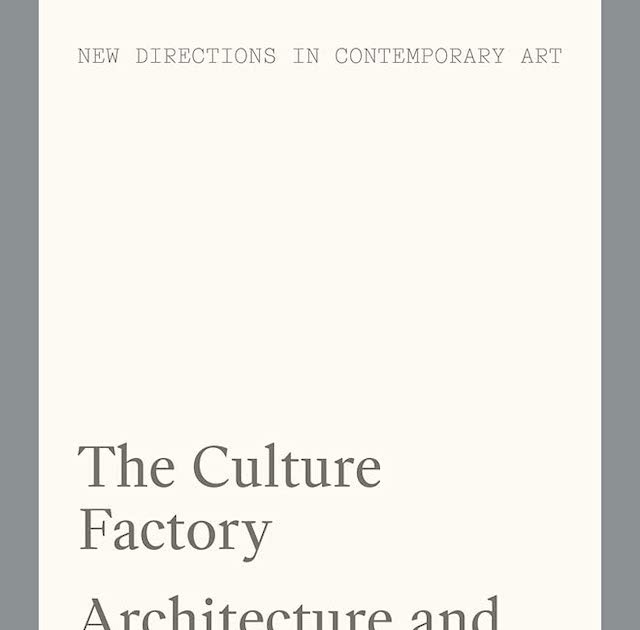The Culture Factory
The Culture Factory: Architecture and the Contemporary Art Museumby Richard J. WilliamsLund Humphries, January 2022Paperback | 5-1/4 x 8 inches | 144 pages | 20 illustrations | English | ISBN: 9781848223974 | $34.95PUBLISHER'S DESCRIPTION:The Culture Factory: Architecture and the Contemporary Art Museum explores the key battlegrounds in the design of the contemporary-art museum, describing the intersection of art, aesthetics and politics at the highest levels, and the commitment of states, cities and wealthy individuals to the display of art. Global in scope, the book examines key examples from Europe and the Americas to contemporary China. It describes museum building as the projection of political power, but also as a desire to acquire power. So it is a book about ambitious peripheries as much as the traditional centres: Dundee and Bilbao as well as New York and Paris.It is commonplace to assume that the contemporary-art museum has become ever more spectacular, and the place of art ever more subservient within it. This book argues that a tendency to spectacle coexists with another equally powerful tendency, to make art museums that celebrate the artistic process, typically attempting to recreate the feeling of the artist's studio. That tendency is strongly represented in the designs for the Centre Georges Pompidou, completed in 1977, and arguably in the many contemporary art museums which have adapted former industrial buildings. Richard J. Williams's stimulating text includes many historical examples to illustrate how we got to where we are now, from the Centre Pompidou in Paris, to the Guggenheim museums in New York and Bilbao, London’s Tate Modern, Oscar Niemeyer's work in Brazil and beyond, and the 798 Art District in Beijing.Richard J. Williams is Professor of Contemporary Visual Cultures at the University of Edinburgh. Among his most recent books are Sex and Buildings (2013), Why Cities Look the Way They Do (2019) and Reyner Banham Revisited (2021).REFERRAL LINKS: REVIEW:Late in the second season of Succession, billionaire media mogul Logan Roy, a fictional character clearly modeled on Rupert Murdoch, celebrates fifty years in the business at a surprise party held at the newly opened V&A Dundee in Dundee, Scotland, Logan's hometown. Designed by Kengo Kuma with a skin of cantilevered concrete shingles, the building strives to be an icon — a beacon of post-industrial urban renewal. The shingled expression continues inside, most strikingly in the sloping walls of the main hall, the double-height space where the party takes place (below). To point out that a 21st-century museum was designed with a large space that can be used for a events is a bit of a "well, duh" statement, but seeing such an event depicted in a widely popular television series means acknowledging the flexible nature of art museums these days. Put simply, art museums are no longer (just) about the art.Screenshot of Succession, S2 E8: "Dundee"Richard J. Williams's brief but enjoyable The Culture Factory critically explores how art museums went from places of art appreciation to spaces of consumption, media, money, and entertainment over the last fifty years. V&A Dundee is one of the roughly two handfuls of museums that Williams discusses in his book that is part of Lund Humphries' "New Directions in Contemporary Art" series. Rather than an influential building changing the course of things, the new V&A, with its semi-public "living room for the city," is indicative of trends taking place this century. The revolutionary buildings that predate it, and which Williams details in two of the book's chapters are the Centre Pompidou in Paris by Piano and Rogers (1977) and Frank Gehry's Guggenheim Museum Bilbao (1997). Although two earlier New York City museums — the Museum of Modern Art and Guggenheim Museum — are mentioned for explicitly embedding "the industrial imagination" in a museum and being "the most obvious reference point" for iconic museum buildings, respectively, the Pompidou and Bilbao anchor Williams's arguments for the transformative nature of museums of the last half-century.Williams describes MoMA's purpose-built home by Philip L. Goodwin and Edward Durell Stone (1939) as "an industrial vision in midtown Manhattan," due to its open-plan, artificially lit spaces that resembled factories; the industrial spaces influenced the Bauhaus and other modernists in the 1920s and 30s. The author jumps from MoMA's industrial vision in the first chapter, "How did we get here?," to the competition-winning design by Renzo Piano and Richard Rogers for the Centre Pompidou, where the building's mechanical innards were moved to the exterior in the most overt expression of factory meeting culture ever achieved. This inside-out maneuver combined with Peter Rice's innovative trusses to create six wide-open stacked floors that could theoretically be filled with almost anything at any time; these expansive spaces are echoed by the sloped plaza that f

by Richard J. Williams
Lund Humphries, January 2022
Paperback | 5-1/4 x 8 inches | 144 pages | 20 illustrations | English | ISBN: 9781848223974 | $34.95
PUBLISHER'S DESCRIPTION:
REFERRAL LINKS:
 |
| Screenshot of Succession, S2 E8: "Dundee" |
 |
| Centre Pompidou (Photo: Jean-Pierre Dalbéra) |
- The Art-Architecture Complex, by Hal Foster, published by Verso, 2011.
- The Art Museum in Modern Times, by Charles Saumarez Smith, published by Thames & Hudson, 2021.
- The Icon Project: Architecture, Cities, and Capitalism, by Leslie Sklair, published by Oxford University Press, 2017.
- Why Cities Look the Way They Do, by Richard J. Williams, published by Polity, 2019.





